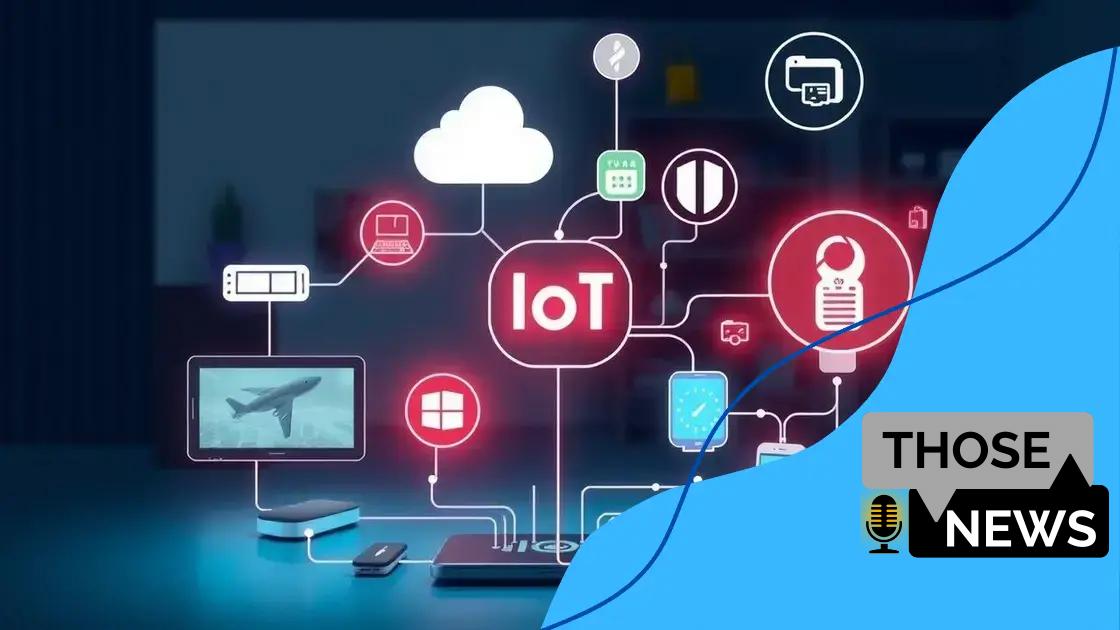Data privacy challenges with IoT devices you need to know

Data privacy challenges with IoT devices arise from vulnerabilities like data breaches and inadequate security, necessitating effective protection measures and compliance with regulations like GDPR and CCPA.
Data privacy challenges with IoT devices are increasingly relevant as the Internet of Things expands its reach into our daily lives. Have you thought about how connected devices might affect your personal data? Let’s explore this pressing issue together.
Understanding IoT and its implications for data privacy
Understanding the Internet of Things (IoT) is crucial for grasping the challenges it poses for data privacy. As more devices connect to the internet, they collect and share vast amounts of personal data.
IoT devices can include anything from smart home devices to wearables. Each of these devices can potentially harvest user data, which can lead to privacy vulnerabilities.
How IoT Works
IoT refers to a network of interconnected devices that communicate and exchange data with one another. This connectivity offers great convenience but also raises significant data security concerns.
Key Privacy Issues
- Data Collection: IoT devices often gather sensitive information without users often realizing it.
- Inadequate Security: Many devices lack robust security features, making them easy targets for cyberattacks.
- Data Sharing: Users may not have control over how their data is shared or used.
- Compliance Concerns: Regulations surrounding data privacy can vary widely, complicating compliance for developers and users alike.
Moreover, understanding how these devices interact with each other is critical. Data flows freely, and without stringent measures in place, personal information can be exposed. Awareness of these interactions is the first step in mitigating risks.
Privacy policies from device manufacturers often fail to clearly communicate how data is managed. Users should read these policies carefully to understand the extent of data collection and usage.
Considering the rapid advancement in IoT technology, individuals and companies must stay informed about changes in regulations and practices that affect their data privacy.
In essence, the growing dependency on IoT devices requires a proactive approach to safeguarding data privacy. The more informed users are, the better they can protect their personal information.
Common data privacy risks associated with IoT devices
Common data privacy risks associated with IoT devices are critical to understand. As devices become smarter, they collect more data, creating new vulnerabilities that can affect consumers and businesses alike.
One significant risk is data breaches. IoT devices often store sensitive personal information, and if not properly secured, this data can be stolen.
Types of Risks
Another concern involves the misuse of data collected by IoT devices. When companies fail to use data ethically, it can lead to privacy violations. Users might unknowingly agree to share information due to vague privacy policies.
Specific Vulnerabilities
- Insecure Networks: Many IoT devices connect through weak or public networks, allowing hackers easy access to information.
- Default Passwords: Users often overlook changing default settings on devices, making it easy for attackers to gain control.
- Unpatched Software: If manufacturers do not release timely updates, vulnerabilities remain for hackers to exploit.
- Lack of User Awareness: Many individuals are unaware of the extent of data collection, increasing the risk of oversharing.
Furthermore, the absence of regulatory standards for IoT data privacy exacerbates these risks. Without clear guidelines, companies may not prioritize security, leaving consumers vulnerable.
Users must take proactive measures to protect their privacy. This can include regularly updating device software, changing default passwords, and being vigilant about what information they share.
Awareness of these risks is essential for ensuring safety in an increasingly interconnected world. The more informed both consumers and manufacturers are, the better the prospects for data privacy.
Best practices for enhancing data security in IoT

Best practices for enhancing data security in IoT are vital for protecting personal and sensitive information. As more devices connect to the Internet of Things, it is essential to adopt measures that improve their security and prevent potential breaches.
One important step is regularly updating the device software. Many manufacturers release updates to fix vulnerabilities. Keeping devices up-to-date helps close security gaps and keeps unauthorized users at bay.
Security Measures for IoT Devices
Another practice involves changing default passwords on IoT devices. Many devices come with generic passwords that are easy for hackers to exploit. By opting for strong, unique passwords, users can significantly enhance their security.
Implementing Additional Security Tools
- Use Network Security: Ensure that devices are connected to a secure network, employing firewalls and VPNs to add extra layers of protection.
- Enable Two-Factor Authentication: This adds an extra step for anyone trying to access your devices, making it harder for unauthorized users.
- Regularly Review Permissions: Check what data your devices are collecting and sharing, and limit permissions to necessary information only.
- Monitor Device Activity: Keeping an eye on device usage can help in identifying unusual behavior, allowing for swift action if needed.
Additionally, educating users about the risks of IoT devices plays a crucial role. Many people are unaware of their devices’ capabilities and the data they may disclose. By being informed, users can take proactive steps to safeguard their information.
Data security also benefits from employing encryption. Encrypting data in transit and at rest adds a layer of protection, making it difficult for cybercriminals to access sensitive information even if they manage to intercept the data flow.
Finally, consider the privacy policies of your IoT device manufacturers. Understanding how they handle your data is key to ensuring your information remains secure.
Legal regulations shaping data privacy in IoT
Legal regulations shaping data privacy in IoT are vital for protecting consumer rights in our increasingly connected world. As IoT devices proliferate, governments are stepping in to create laws that govern how personal data is collected, stored, and used.
One notable regulation is the General Data Protection Regulation (GDPR) in Europe. This law establishes strict guidelines for data protection and privacy, impacting any organization that processes the personal data of EU citizens, regardless of where the organization is located.
Key Regulations Affecting IoT
Many countries are enacting their data privacy laws, which resonate with the principles of the GDPR. For instance, the California Consumer Privacy Act (CCPA) enhances privacy rights and consumer protection for residents of California. Compliance with these laws is crucial for IoT companies as failure to comply can result in hefty fines.
Privacy by Design
- Implementation of Security Measures: Regulations often require companies to incorporate security measures from the start, ensuring that IoT devices are secure by design.
- User Consent: Many laws mandate obtaining explicit consent from users before collecting or processing their data.
- Data Breach Notifications: Regulations may specify that companies must notify users of data breaches promptly.
- Right to Access: Users are granted the right to access their data and request its deletion, enhancing personal control over information.
Furthermore, global harmonization of data privacy laws is essential as IoT devices often operate across borders. This complexity adds to the challenge of compliance, as each jurisdiction may have different requirements and legal interpretations.
As advancements in technology continue, regulations will likely adapt in response to new challenges. This necessitates that organizations involved with IoT remain vigilant and proactive regarding compliance.
Overall, the important role of legal regulations in shaping data privacy cannot be underestimated. They provide a framework for protecting user rights while fostering trust and security in the growing IoT landscape.
Future trends in IoT and data protection strategies
Future trends in IoT and data protection strategies are evolving rapidly as technology advances and new threats emerge. The landscape of connected devices is constantly changing, making it vital to stay ahead of potential issues.
One trend is the increasing use of artificial intelligence (AI) in IoT devices. AI can enhance data protection by identifying patterns and anomalies in user behavior, thus helping to detect potential breaches before they occur.
Emerging Technologies for Data Protection
Another innovation is the implementation of blockchain technology. By using distributed ledger systems, IoT devices can ensure data integrity and secure transactions without relying on a central authority. This decentralized approach can vastly improve user trust.
Enhanced User Control
- User-Centric Privacy Features: Future devices may have built-in features allowing users to control what data is shared and when.
- Real-Time Data Monitoring: Advanced monitoring tools will enable users to track data usage and receive alerts for unusual activities.
- Increased Focus on Compliance: As regulations evolve, IoT devices will likely need to adapt quickly to maintain compliance with data protection laws.
- Privacy by Design: Companies will adopt privacy as a critical component of the design process, integrating security measures from the start.
Moreover, the demand for more robust security protocols is growing. Manufacturers will need to prioritize security at every device lifecycle stage, from production to deployment. This approach focuses on minimizing vulnerabilities that hackers can exploit.
Data protection strategies will also emphasize educating consumers. Users who understand the capabilities and risks associated with their IoT devices will use them more responsibly and securely.
In summary, as the IoT landscape continues to evolve, staying informed about future trends in data protection is essential. Embracing new technologies and approaches will be critical in safeguarding personal information in an increasingly connected world.
In conclusion, as the Internet of Things (IoT) continues to expand, understanding data privacy challenges becomes increasingly important. With the rise of new technologies and regulations, users and manufacturers must prioritize data protection. Implementing best practices, complying with legal standards, and staying informed about future trends are essential steps to ensure the safety of personal information. By being proactive, we can enjoy the benefits of IoT while minimizing risks.
FAQ – Frequently Asked Questions About Data Privacy in IoT
What is the biggest data privacy risk associated with IoT devices?
The biggest risk is data breaches, as many IoT devices collect sensitive data that can be targeted by hackers.
How can I protect my data when using IoT devices?
You can protect your data by regularly updating device software, changing default passwords, and using secure networks.
What legal regulations influence data privacy for IoT?
Regulations like GDPR in Europe and CCPA in California set strict guidelines for how personal data is collected and used.
How do emerging technologies improve data protection in IoT?
Emerging technologies like AI and blockchain enhance data protection by providing better security measures and ensuring data integrity.





